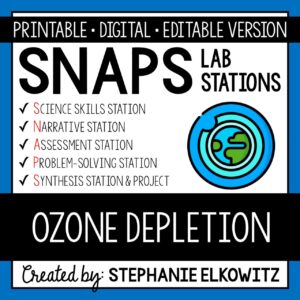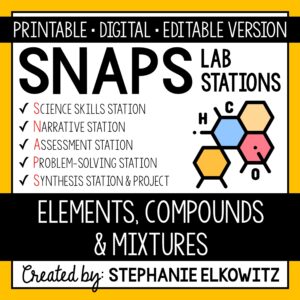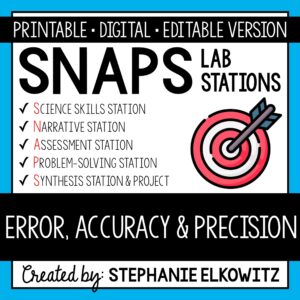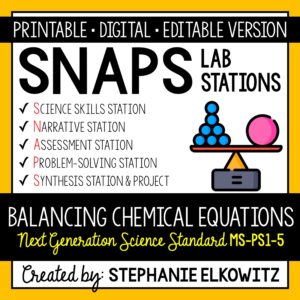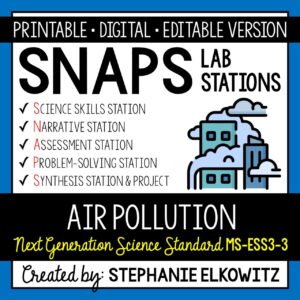MS-ESS3-3 Conservation and Sustainability Lab
$7.00
An engaging lab activity designed to enhance students’ understanding of conservation and sustainability and help students apply scientific ideas to the real world. Aligned with NGSS MS-ESS3-4.
Description
MS-ESS3-3 Conservation and Sustainability Lab Preview
SNAPs Lab Stations Activities require students to use science, math, literacy, problem-solving and engineering skills. They are designed to enhance students’ understanding of scientific concepts and help students apply scientific ideas to the real world. Each station activity promotes skills so to develop students into proficient and competent scientific thinkers.
SNAPs lab activities have five components:
• Science Skills Station to develop science skill proficiency
• Narrative Station to build science literacy
• Assessment Station to evaluate learning and understanding
• Problem-Solving Station to foster engineering design
• Synthesis Station and Project to inspire higher-order learning
DIGITAL LABORATORY – DISTANCE LEARNING & DIGITAL CLASSROOMS
• This lab is offered in a digital format to support digital classrooms & distance learning.
• The digital lab activity is designed to work with Google Slides and Microsoft PowerPoint
• The digital lab activity CANNOT be edited. However:
– Students can manipulate text boxes
– Students can create tables, graphs and diagrams
– Students can insert images and drawings
GOOGLE FORM ASSESSMENT STATION
• The assessment station is offered as a self-grading Google Form.
• Questions are all short answer and are 100% editable.
• Suggestions for use are included in the download.
DISTANCE LEARNING COMPATIBILITY
SNAPs lab activities are rated for their ease with distance – independent learning. Refer to the preview for more information about how well this laboratory works in a fully digital classroom and with distance learning.
EDITABLE DOCUMENTS
This download includes an editable word document (docx file) of all lab components:
• Pre-Lab and Post-Lab Activities
• The Lab Overview
• Lab Station Activities and Questions
• Directed Synthesis Project (when applicable)
Important Notes:
• Diagrams, illustrations, tables and graphs essential to lab activities are included
• Illustrative clipart is NOT included
• Editable documents and rubrics are included with the FREE SNAPs Setup Guide
Editable files allow you to:
• Edit the scope of the activities so to suit your students’ needs
• Edit the materials required based on resource availability
• Create single-period “mini-labs” using activities at the individual skills stations
The activities at each station in this lab are detailed below.
Conservation and Sustainability Lab Stations Activity Learning Objectives:
1. Identify how the use of natural resources negatively impacts Earth’s ecosystems.
2. Discuss how sustainability is important to preserving natural resources for future generations.
3. Apply scientific principles relating to conservation and sustainability to develop feasible solutions that manage environmental problems.
Science Skills Station
Students will investigate deforestation and water usage at this station. They will study how we use trees and water resources and identify ways humans can sustain trees and water resources so they will be available and usable for future generations.
Narrative Station
Students will read an informational text about ways humans can conserve Earth’s environments and resources. Students will read about sustainability and the balance of using Earth’s resources to maintain our way of life while protecting Earth’s resources so they are available for future generations.
Assessment Station
At this station, students will answer questions about key terms and ideas relating to conservation and sustainability. Students must employ lower, mid and higher order thinking skills to answer these questions.
Problem-Solving Station
Students will assess the impact of an environmental problem and the value of a solution to that problem. Students will use problem-solving skills to develop a better solution to that problem. Students will have to balance the conservation of natural resources and the environment with the growth of society and quality of life.
Synthesis Station
Students will compose a CER (claim-evidence-reasoning) report to summarize the lab. Students are provided the claim statement and must support the claim with observations, data and other information gathered in the lab. Students will explain how the evidence supports the claim using scientific reasoning.
Synthesis Project
Students will have a choice of 11 projects. Refer to the SNAPs Lab Stations Best Practices and Setup Guide for directions and suggestions on how to conduct the project.
Directed Synthesis Project
Students can conduct one of the 11 standard synthesis projects, but I strongly suggest using the directed synthesis project to supplement NGSS MS-ESS3-5 and to best integrate and apply the information learned in this lab. In the directed project, students will argue how to most effectively and feasibly employ conservation efforts while maintaining the quality of life. Students will make suggestions on ways to keep environments healthy, pure and productive while allowing society to grow and improve.
This download includes:
• A pre-lab assignment and post-lab reflection
• Directions and questions for each lab station
• Student recording sheets
• Teacher Key
Additional Materials Required:
2 Computers or tablets
1 World map (optional)
NEXT GENERATION SCIENCE STANDARDS
This laboratory satisfies NGSS MS-ESS3-3. It combines the three dimensions of science learning – science and engineering practices, disciplinary core ideas and crosscutting concepts – to meet the standard. This lab also makes interdisciplinary connections to STEM, Math CCSS and ELA CCSS to build the appropriate skills.
TERMS OF USE
• All rights reserved by Stephanie Elkowitz.
• This product is to be used by the original purchaser only.
• Intended for classroom and personal use only.
• Copying for more than one teacher, classroom, department, school, or school system is prohibited.
• This product may not be distributed or displayed digitally for public view.
• Failure to comply is a copyright infringement and a violation of the Digital Millennium Copyright Act (DMCA).




